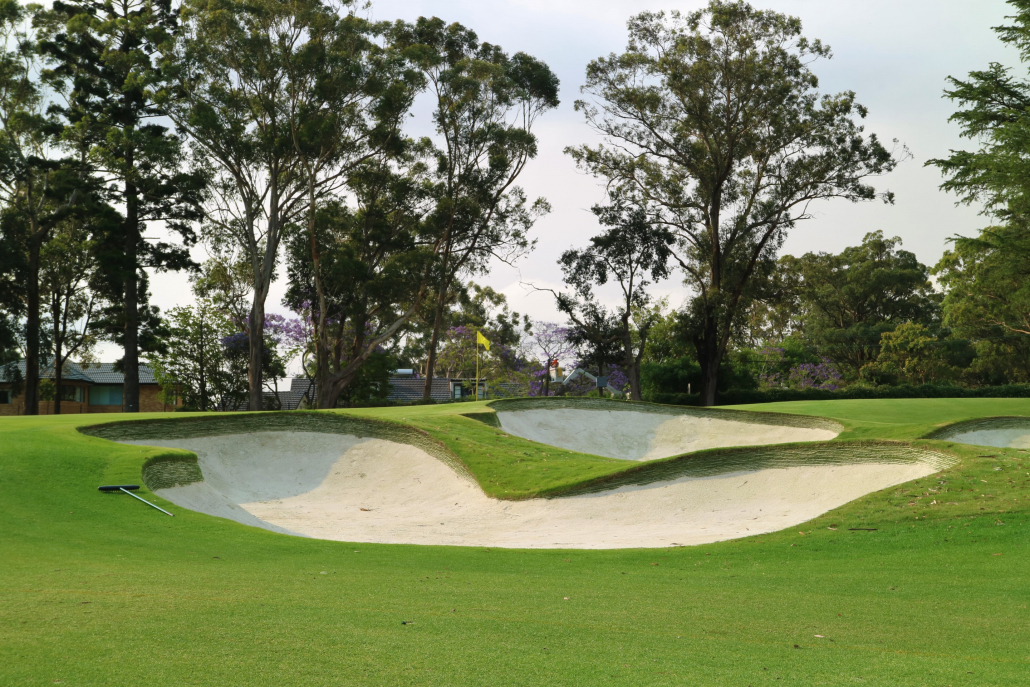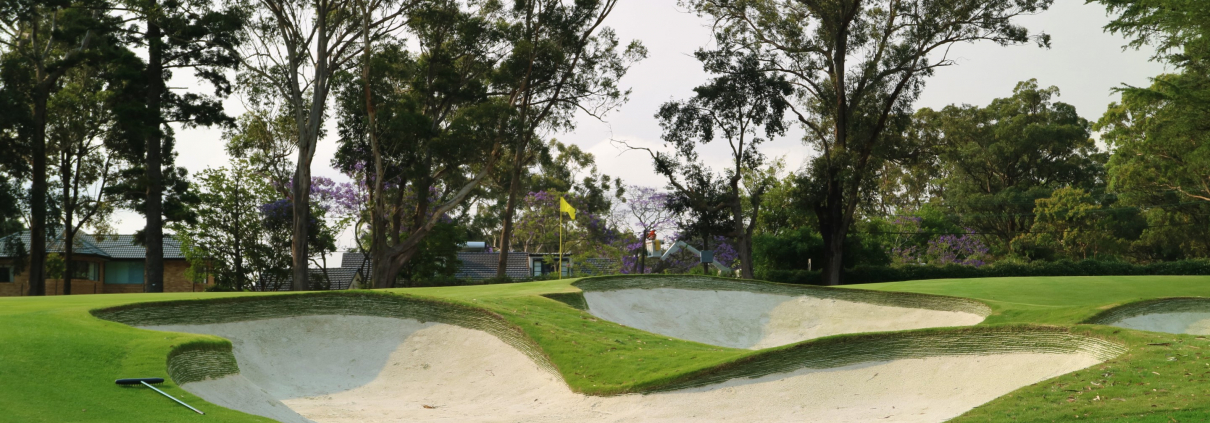Ecobunker enables Sandbelt style bunkers
Ecobunker enables Sandbelt style bunkers: The famous courses of the Melbourne Sandbelt, notably Royal Melbourne and Kingston Heath, are distinctive for many reasons, but one of the most important is the characteristic bunker style created by Dr Alister MacKenzie and his collaborators Alex Russell and Mick Morcom.
Sandbelt bunkers are characterised by their size, by their swooping shape, with capes and bays dividing them up into different compartments, by their flashed sand faces, and by the fact that they cut so deeply into fairways and greens – and are typically presented with short grass – fairway or even green cut – right up to the edge of the bunker, with no collar of longer grass that can interfere with the architect’s desired short game playability, and create visual interference in an otherwise extremely ‘clean’ look.

That look has been enormously influential around the world of golf. Gil Hanse’s Olympic course in Rio de Janerio and Tiger Woods’ first American design, Bluejack National in Texas, are only two in a long list of courses said by their designers to be influenced by the Sandbelt look. But replicating those trademark Melburnian bunkers is hard. The soil on the Melbourne courses, though sandy, contains a lot of fine particles and grey organic matter that mean it binds together to create a hard surface. Coarser sand – and even more so, clay soil – does not bind the same way, and creating that hard, vertical lip so characteristic of Melbourne is basically impossible; the soil gets wet and crumbles away.
The recent President’s Cup at Royal Melbourne showed very well how the Sandbelt bunkers work. As well as the clean edge, the sand packs down so hard that Melbourne clubs do not rake their bunker faces, rather using a ‘flat rake’ to create extremely firm conditions on the bunker faces, ensuring that all balls that enter the bunker run down to the prepared base, removing the problem of plugged lies.
So Sandbelt bunkers are desirable, but they depend completely on the particular conditions on the Sandbelt to make them possible. Sydney-based golf architect Harley Kruse has found a way round this problem. At Killara Golf Club, in the northern suburbs of Sydney, a successful 1800 member club whose golf course was basically untouched since the 1960s, Kruse was hired to do a significant course renovation. After careful planning, the works were agreed: reconstruction of all eighteen green complexes, reversing two holes, rebuilding some fairway bunkers and eliminating one par three while bringing a spare hole into the normal rotation.
“Greens were suffering; the rootzone wasn’t good and they were all poa,” Kruse says. “They were small, averaging 370 sq, and basically flat, with very limited strategic value. We have increased them to an average size of 500-550 sq m, with lots more interest; we’ve also taken out 300 big trees and opened up the vistas.”
Kruse and the club wanted sandbelt-inspired bunkers, but the clay soil at Killara meant that was going to be difficult. However, they found a solution via a good friend, Rod Hinwood, course manager at the exclusive Ellerston GC in rural New South Wales. Hinwood demonstrated the successful results that EcoBunker was delivering on his pronounced bunker edges, which had previously been vulnerable to erosion. “It occurred to me that we might be able to do something similar at Killara, and thus be able to get the edging treatment that we wanted,” said Kruse.
The new bunkers are lined with Capillary Concrete, and feature a 40cm high lip constructed using EcoBunker Advanced patented synthetic bunker edging system. The sand is then flashed up the EcoBunker wall – and is held in place by the Capillary Concrete – and the bunker surrounds can be mowed short right to the edge, because of the strength the EcoBunker and Capillary Concrete underpinnings provide.
“EcoBunker was designed from the outset to give architects the maximum freedom to create the bunker shapes they wanted,” says EcoBunker inventor and CEO Richard Allen. “The work that Harley has done at Killara is a classic example of that. When I first went to Melbourne last year, the principal reason was to see the Sandbelt bunkers up close; the fact that our product has allowed a great architect to create similar bunkers on unsuitable soil is fantastic. This style of bunker has long been something of a ‘holy grail’ for a lot of golf courses that simply haven’t been able to implement it because of their soil conditions. Now, they can see a proven solution that will allow them to do so.”
“If we had tried to do that edge using the site soils, it would crumble away,” says Kruse. “Getting that stable lip in clay soils is very difficult to achieve. But EcoBunker allows us to do it.”
For the latest industry news visit turfmatters.co.uk/news
Get all of the big headlines, pictures, opinions and videos on stories that matter to you.
Follow us on Twitter and Instagram for fun, fresh and engaging content.
You can also find us on Facebook for more of your must-see news, features, videos and pictures from Turf Matters.











